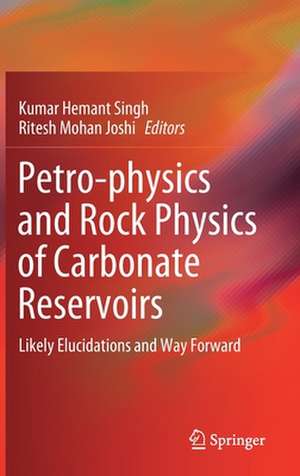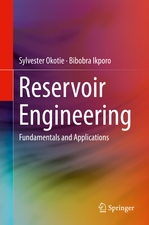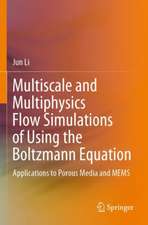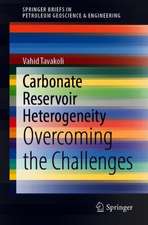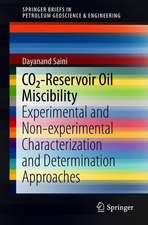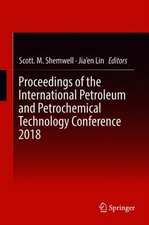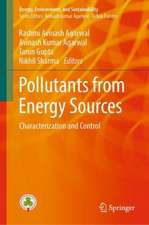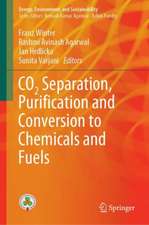Petro-physics and Rock Physics of Carbonate Reservoirs: Likely Elucidations and Way Forward
Editat de Kumar Hemant Singh, Ritesh Mohan Joshien Limba Engleză Hardback – 17 oct 2019
Preț: 429.61 lei
Nou
Puncte Express: 644
Preț estimativ în valută:
82.20€ • 86.06$ • 68.02£
82.20€ • 86.06$ • 68.02£
Carte tipărită la comandă
Livrare economică 05-19 aprilie
Preluare comenzi: 021 569.72.76
Specificații
ISBN-13: 9789811312106
ISBN-10: 9811312109
Pagini: 350
Ilustrații: XI, 299 p. 175 illus., 140 illus. in color.
Dimensiuni: 155 x 235 mm
Greutate: 0.61 kg
Ediția:1st ed. 2020
Editura: Springer Nature Singapore
Colecția Springer
Locul publicării:Singapore, Singapore
ISBN-10: 9811312109
Pagini: 350
Ilustrații: XI, 299 p. 175 illus., 140 illus. in color.
Dimensiuni: 155 x 235 mm
Greutate: 0.61 kg
Ediția:1st ed. 2020
Editura: Springer Nature Singapore
Colecția Springer
Locul publicării:Singapore, Singapore
Cuprins
Geological Processes in Carbonates: porosity and permeability distribution.- Carbonate Rock Characterization Techniques: Historical perspective and Future Trends.- Integration of log with core data.- Empirical models in carbonate reservoirs.- Petrophysical and rock physical models.- Seismic reservoir characterization, latest trends and solutions.
Notă biografică
Dr. Kumar Hemant Singh, is an associate professor of Geophysics at the Department of Earth Sciences, Indian Institute of Technology Bombay, Mumbai, India. He formerly worked as an associate research scientist at the University of Maryland, Baltimore, USA (2009-2011) and as a postdoctoral fellow (NPP) administered through Oak Ridge Associated Universities, Oak Ridge, USA (2007-2009), during which time he worked as a solid-earth geophysicist at the NASA's Goddard Space Flight Center (GSFC). He briefly served as a lecturer at the School of Earth and Environment, University of Leeds, UK in 2006. He completed his Ph.D. at the Freie Universität, Berlin, Germany in 2003 and continued his postdoctoral research in the field of satellite geomagnetism at the Geo Forschungs Zentrum Potsdam, Germany. As a consultant to Shell Oil, The Netherlands and GETECH, UK, he contributed immensely to the mapping of Curie Isotherms in the parts of North America, Europe, Australia and the Middle East. Dr Singh has been extensively involved in the modeling and interpretation of global lithospheric magnetic field models and heat flow data to understand the structure, composition and dynamics of the Earth’s crust. His recent contributions are related to reservoir characterization based on petrophysical, rock physics and shallow sub-surface geophysical data using machine learning and deep learning algorithms.
Ritesh Mohan Joshi is a reservoir geophysicist and is currently pursuing research at the Indian Institute of Technology Bombay (IIT Bombay), India. He is an expert in the seismic interpretation and identification of prospects, structural and stratigraphic mapping, domain conversion and attribute analysis, CSEM data analysis, 3D seismic visualization and volume-based interpretation methods, and has extensive experience in inland and offshore shallow and deep water systems. His illustrious 18-year career includes two inland projects at HOEC, India, whichled to the successful drilling of two hydrocarbon-producing wells; the development of software related to reservoir characterization at Schlumberger, Houston; evaluation of Indian sedimentary basins for their hydrocarbon prospects at Petra Energia, Brazil; seven years engaged in deep water exploration projects on the East Coast of India, particularly in the KG and Mahanadi Basins, as well as new ventures such as theevaluation of projects at BG Group, UK (now Shell). His most recent job with EMGS Malaysia involves reservoir characterization for basins in the Andaman Sea, Myanmar offshore, Sarawak, Sabah, AW Shelf Australia, Makassar Strait, andTaranaki (NZ), among others. Mr. Joshi has also been a judge for the AAPG’s prestigiousImperial Barrel Award (Asia-Pacific), visiting scholar at Trisakti University, Indonesia, and presenter of the award-winning paper at IPA, Jakarta.
Ritesh Mohan Joshi is a reservoir geophysicist and is currently pursuing research at the Indian Institute of Technology Bombay (IIT Bombay), India. He is an expert in the seismic interpretation and identification of prospects, structural and stratigraphic mapping, domain conversion and attribute analysis, CSEM data analysis, 3D seismic visualization and volume-based interpretation methods, and has extensive experience in inland and offshore shallow and deep water systems. His illustrious 18-year career includes two inland projects at HOEC, India, whichled to the successful drilling of two hydrocarbon-producing wells; the development of software related to reservoir characterization at Schlumberger, Houston; evaluation of Indian sedimentary basins for their hydrocarbon prospects at Petra Energia, Brazil; seven years engaged in deep water exploration projects on the East Coast of India, particularly in the KG and Mahanadi Basins, as well as new ventures such as theevaluation of projects at BG Group, UK (now Shell). His most recent job with EMGS Malaysia involves reservoir characterization for basins in the Andaman Sea, Myanmar offshore, Sarawak, Sabah, AW Shelf Australia, Makassar Strait, andTaranaki (NZ), among others. Mr. Joshi has also been a judge for the AAPG’s prestigiousImperial Barrel Award (Asia-Pacific), visiting scholar at Trisakti University, Indonesia, and presenter of the award-winning paper at IPA, Jakarta.
Textul de pe ultima copertă
This book presents selected articles from the workshop on "Challenges in Petrophysical Evaluation and Rock Physics Modeling of Carbonate Reservoirs" held at IIT Bombay in November 2017. The articles included explore the challenges associated with using well-log data, core data analysis, and their integration in the qualitative and quantitative assessment of petrophysical and elastic properties in carbonate reservoirs. The book also discusses the recent trends and advances in the area of research and development of carbonate reservoir characterization, both in industry and academia. Further, it addresses the challenging concept of porosity portioning, which has huge implications for exploration and development success in these complex reservoirs, enabling readers to understand the varying orders of deposition and diagenesis and also to model the flow and elastic properties.
Caracteristici
Discusses the latest (methodology/modeling/interpretation) in carbonate reservoir characterization Focuses on geophysical investigations, including geological processes Addresses all facets of reservoir modeling— from geology to geophysics of carbonates
